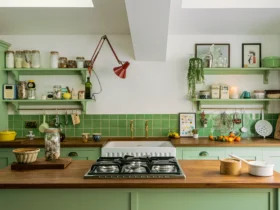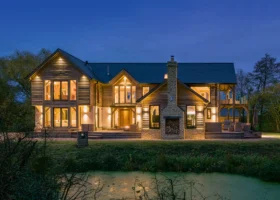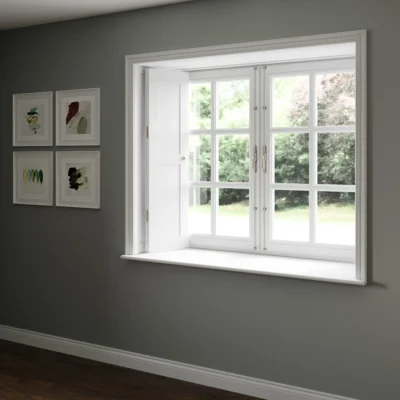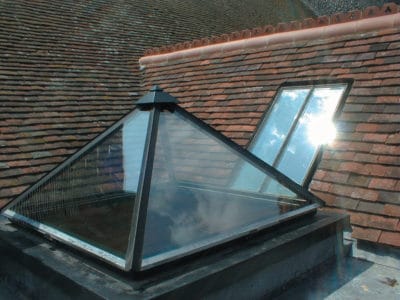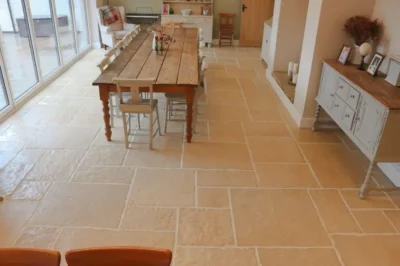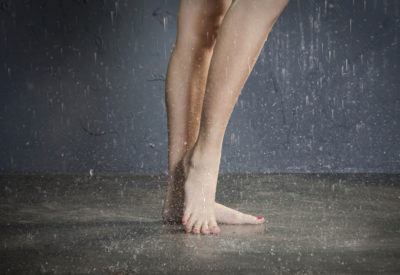Bathroom Design: How to Plan an Effective Bathroom Layout & Scheme
An effective, well-planned bathroom design will require a few key considerations – from deciding on a functional layout to installing proper ventilation that’ll ensure a healthy space. But where to start?
Now more than ever, the bathroom is viewed as a place of personal relaxation, and this has paved the way for a handful of new schemes that take a more decorative approach to designing this functional space. This also means that most self builders and renovators will budget more for their bathroom design, including additions such as smart home technology, automated lighting and underfloor heating.
The first bathroom design step is to consider how the room will be used by the dwelling’s occupants. “By day we need a functional zone, but at night we want to be able to retreat and relax,” says Kate Griffiths from Kohler. Whether you’re creating your own bathroom from scratch or updating an existing suite, there’s many practical factors to bear in mind before splashing out on that freestanding tub you’ve had your eye on, for instance.
From flooring to heating, lighting and ventilation, here we’re taking a look at each of the components that need to be considered for a practical and lasting bathroom design.
Choosing the Right Flooring for Your Bathroom Design
Practicality is the main consideration when it comes to specifying a floor covering that works with your bathroom design. It’s essential to select a water-resistant surface that won’t become slippery when wet. Low-maintenance, stain-proof and easy to clean, porcelain tiles are a top choice.
“A huge advantage of this material is that the units can be manufactured in a range of realistic finishes, including marble, limestone, concrete and wood. This makes it possible to achieve the look you want without the challenges of regular upkeep,” says Chris Grainger from Stone & Ceramic Warehouse. “We recommend a tile with a matt, textured surface. This will ensure the floor is anti-slip and safe.”
Thanks to their excellent conductivity, porcelain and ceramic tiles are also great partners for underfloor heating. “If you do opt for tiled flooring then consider the size and format as well as the material, as this can affect the overall feel of your bathroom design,” says Lisa Elbourn from Fired Earth. “A larger unit with less grout joints can help the space appear bigger and less cluttered.”
Essential Inspiration: Bathroom Ideas: Clever Bathroom Designs For Your Self Build or Renovation
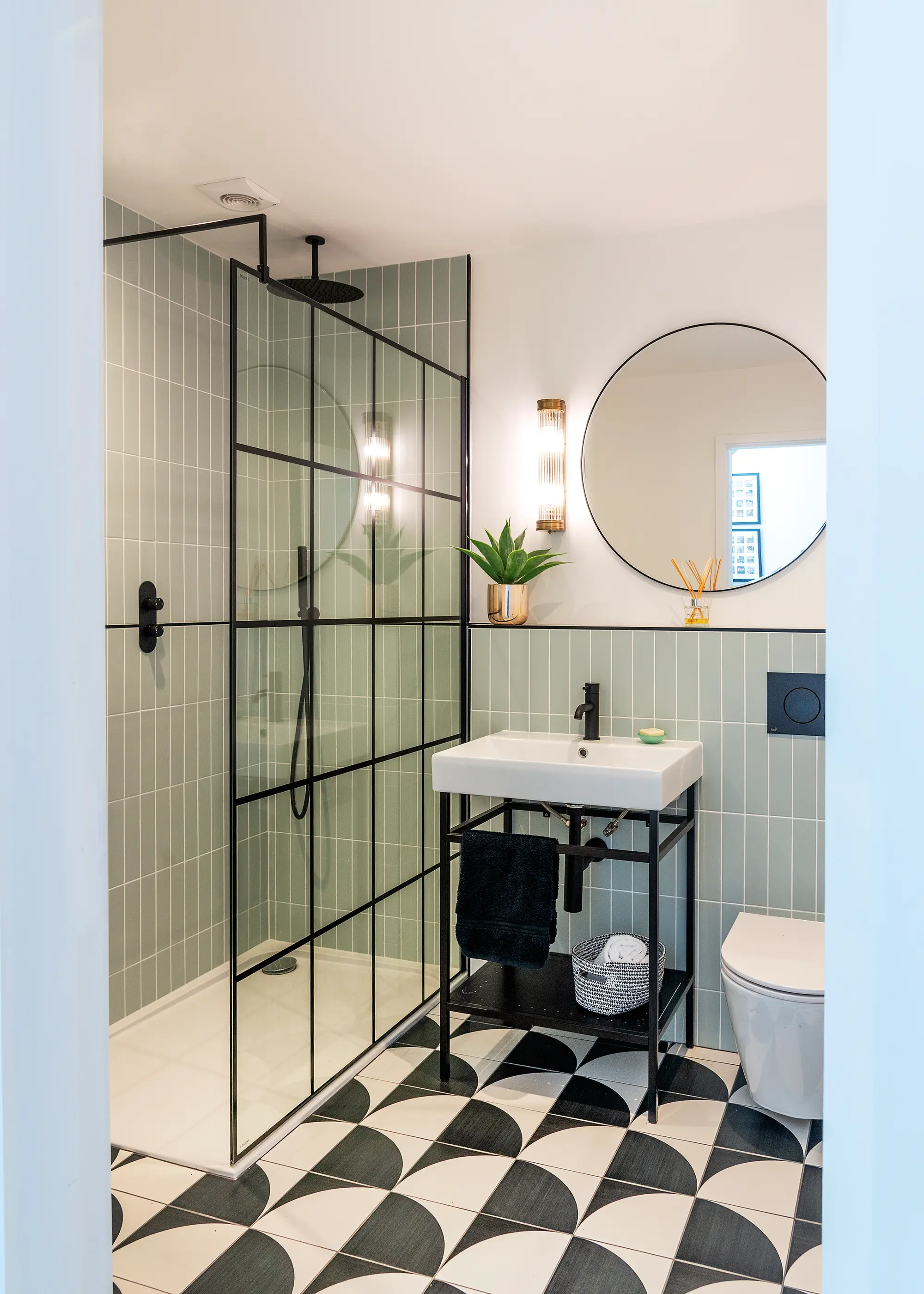
The Horsteads‘ bathroom features eye-catching patterned tiles on the floor. The overall scheme is contemporary and functional, with a walk-in shower for ease and mirrors placed next to the mirror for effective illumination
If your heart is set on a natural stone covering, slate, marble and limestone are all suitable for use in the bathroom. However, bear in mind that if you do opt for this material, floor joists may need to be reinforced to take the extra weight. Plus, the surface should be occasionally re-sealed as stone is a porous material.
Solid wood flooring won’t be the best option for a bathroom floor as it can be susceptible to warping in damp or warm conditions. Engineered wood flooring expands and contracts less when there are changes in humidity and temperature, so it can work great in a bathroom design.
It’s also a viable option for underfloor heating, as it is stable enough to resist warping; although it’s not as conductive as tiles or stone. “Engineered wood flooring is the best choice for use with underfloor heating due its high level of stability and resistance against warping,” says Thea from Russwood.
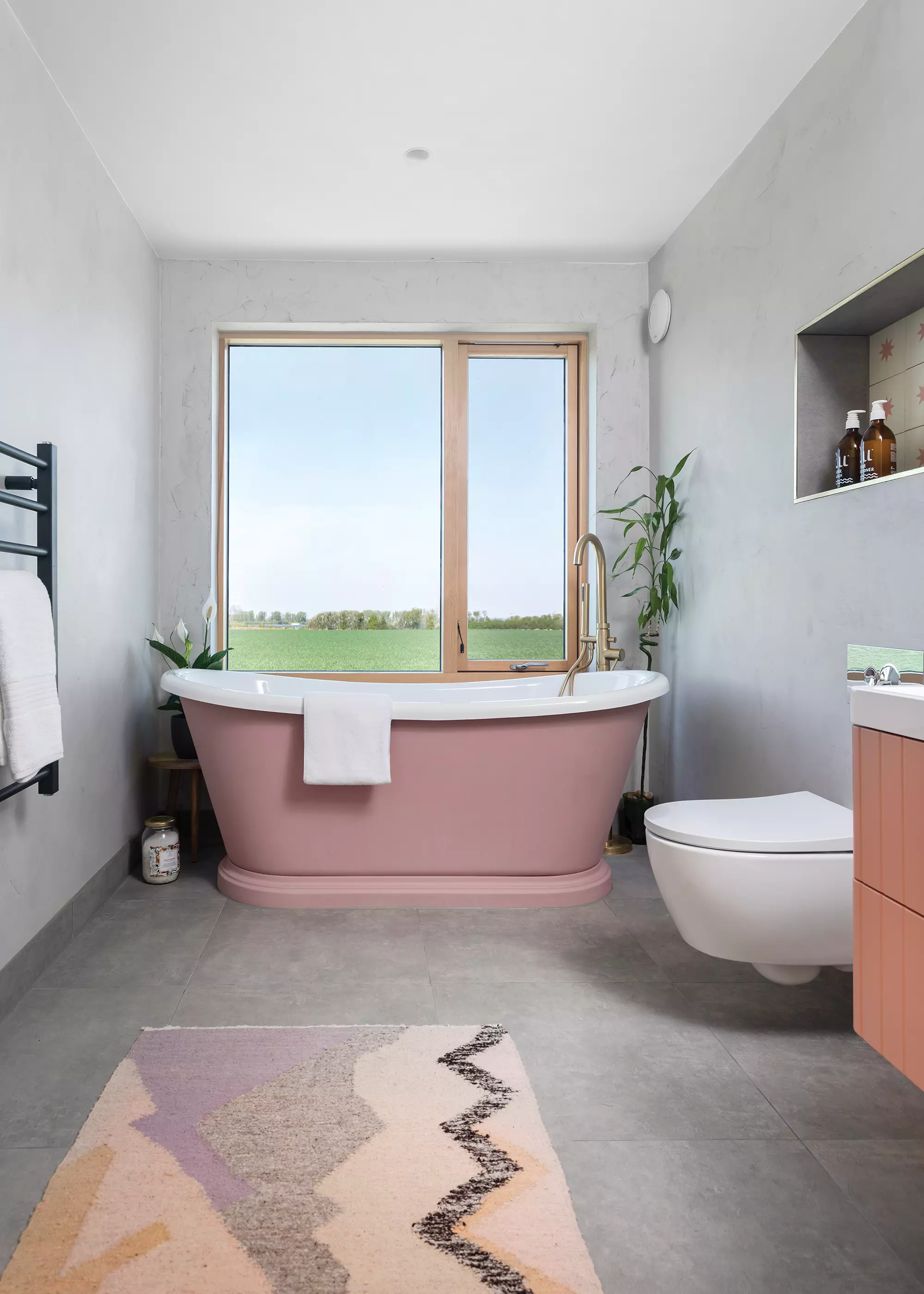
The Packs have made use of large glazing and brightly toned features in the bathroom to bring a light and open feel. Photo: Richard Gadsby
A popular option for modern bathrooms, polished concrete floors are durable, low maintenance and stylish. This flooring is made by combining concrete (cement, sand, water and gravel) with a chemical that increases its density. This ensures that when the concrete is poured and sanded down, it’ll reveal a sheen. It’ll typically cost £120 to £150 per m², but prices will vary, depending on factors such as the level of sheen required.
Concrete has a high thermal mass so is able to store and maintain a stable temperature, making it a great partner for an efficient UFH install, too.
If you’re working with a tighter budget, vinyl can be a wallet-friendly alternative to the above materials. It’s extremely easy to clean and comfortable underfoot. It’s available in a whole host of patterns and colours to suit your bathroom design, some with slate or marble-effect finishes. This floor covering tends to cost in the region of £20 to £70 per m² and is compatible with underfloor heating.
Essential Advice: Complete Guide to Flooring For Your Home: How to Choose the Right Flooring For Each Room
Bathroom Lighting Design
Incorporating a layered lighting scheme into your bathroom design the outset will help ensure a setup that meets your needs. “Think carefully about the lighting required from a practical point of view,” says Lisa from Fired Earth. “It would be frustrating if the room was dark and dingy when you’re in a rush in the morning, for example. Consider how the level of illumination can suit a relaxing ambience, too.”
A main fixture positioned in the centre of the room will provide the brightness you need for everyday tasks, such as showering. Some homeowners choose to incorporate ornamental chandeliers or other striking fittings to create an eye-catching focal point.
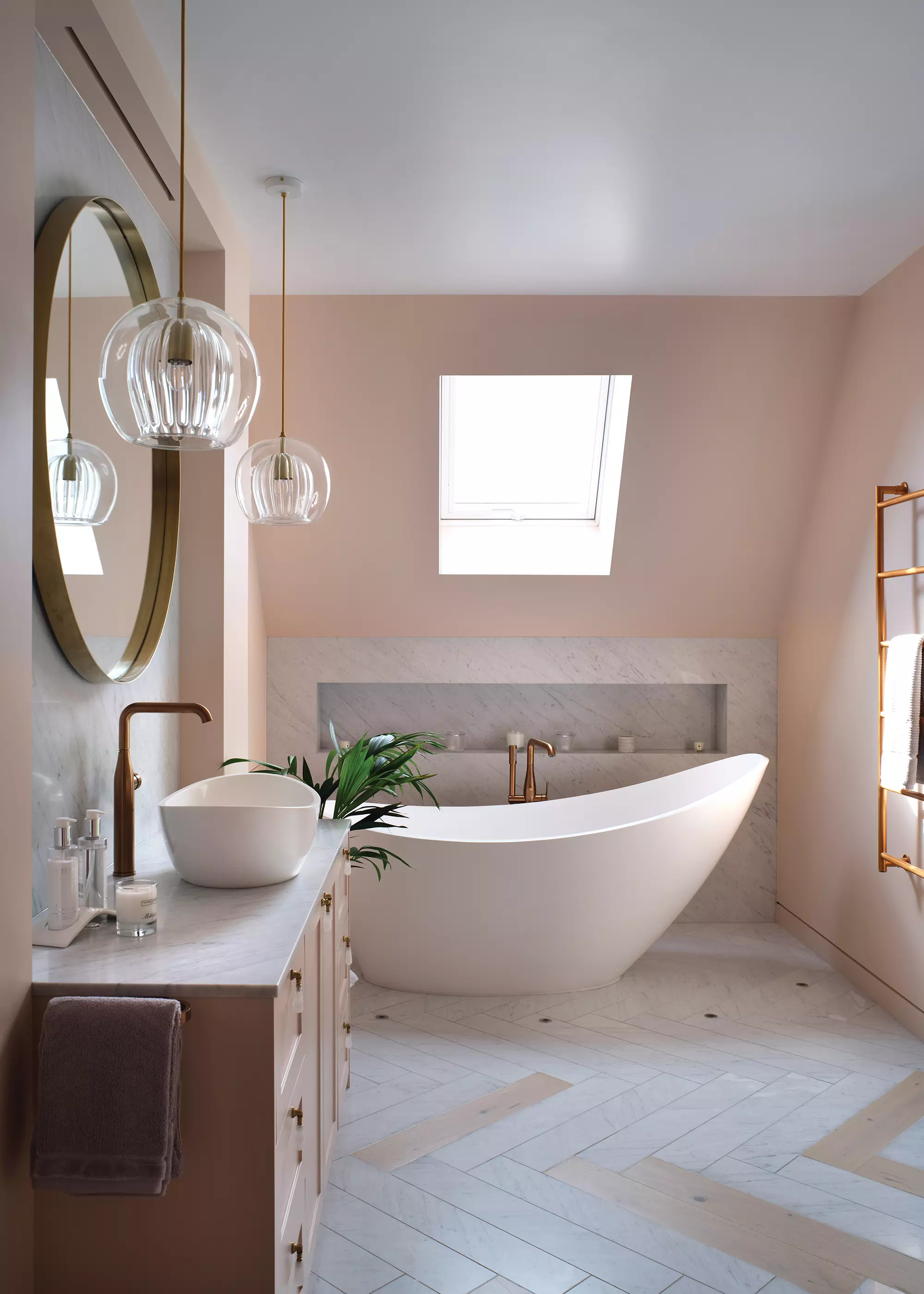
The Charneys carefully selected a fusion of pinks, marble and brass to create the perfect bathroom in their self build home, designed by Robert Hirschfield Architects, with interiors by Studio Suss. It features pendant glass globe lights either side of the sink create a dramatic addition. Photo: Philip Vile
“Task lighting around mirrors is essential,” says Lisa. “This can be achieved with separate fittings that are wall-mounted, or you can buy mirrors or cabinets that incorporate lighting, too. Spotlights within the floor or along the base of a wall can also help to create a relaxed, spa-like atmosphere.”
Fitting several circuits with individual controls will help you to dim and brighten the room as desired. All electrical installations need to comply with the Building Regulations – and you’ll need to specify appropriate IP-rated products to protect against moisture ingress.
Learn More: Lighting Design: The Ultimate Homeowner’s Guide
Incorporating Smart Home Automation into Your Bathroom Design
If your budget will allow it, you can explore the possibility of smart home automation systems that will operate your lighting, heating and outlet settings efficiently. For example, some baths and showers come with digital controls that can be used to adjust the temperature and flow of water. Techy features such as automated sound systems can add an extra flourish of luxury, too.
Designing Your Bathroom’s Heating & Ventilation
Adequate ventilation is essential for this zone, as the humid environment and prolonged contact with moisture may otherwise cause damp to take hold. According to Building Regs Part F, either a window or a suitable extractor fan should be incorporated to ensure the bathroom receives an adequate supply of fresh air.
A growing number of self-builders are opting to incorporate mechanical ventilation and heat recovery (MVHR) systems, which work by extracting moist air from wet zones such as kitchens and bathrooms, recycling the heat and distributing a fresh supply to other rooms at the same time.
If you’re tackling a renovation, an alternative solution is to fit a ducted fan on the ceiling of the bathroom. It’s best to position the fan on an exterior wall of the property so waste air can be easily directed outside.
Once ventilation is taken care of, it’s time to decide on heating. While radiators are the traditional choice, many homeowners are doing away with them to free up precious wall space, laying underfloor heating (UFH) instead.
Providing an even spread of heat throughout the room and cosy warmth underfoot, UFH is the preferred choice for many self builders. “Having a warm floor also means any water on tiles will quickly evaporate, making it safer and less slippery,” says Chris from Stone & Ceramic Warehouse.
A range of slim retrofit systems is available for renovators who want the benefits of UFH without the extra floor build-up. If you do choose to have radiators, select a model that can deliver the required heat output for the room. Heated towel rails are an alternative, and some models can be used to form an attractive design feature.
Thinking about you’re going to heat your bathroom? Read more: Choosing Heating Systems: Radiators or Underfloor Heating?
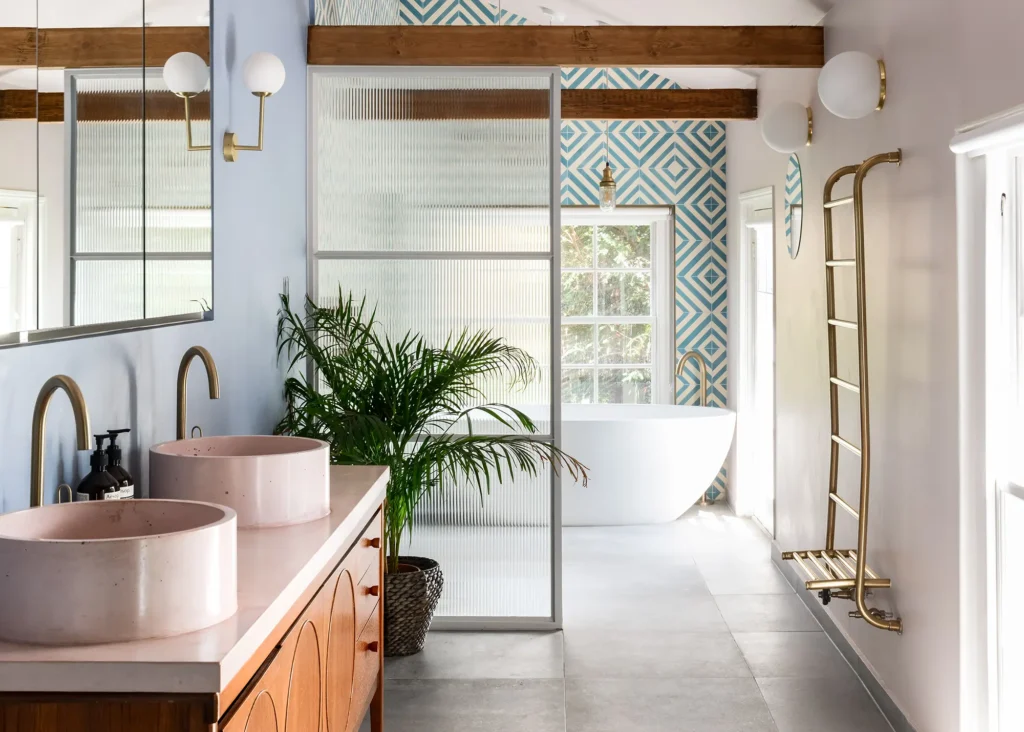
MW Architects created a striking bathroom that contains both contemporary and mid-century design features. The reeded glass partition wall sections the bathing area off from the sink units, creating defined spaces that offer privacy and functionality. Photo: French + Tye
Installing Your Bathroom’s Sanitaryware
Striking the right balance between practicality and aesthetics can be a challenge, especially given the varied array of functions a bathroom has to perform.
“When it comes to deciding where you’re going to position fittings, the best way forward is to think about how they’re used and in what order,” says Phil Etherden from The Albion Bath Co. “We often recommend that the basin is placed closest to the door, as it’s often the last stop in most bathroom routines. The WC and other fittings can be positioned further into the room.”
If you’re renovating, it’s worth thinking about the aspects you currently dislike and what you’re keen to change. For example, are you frustrated by a lack of storage space? Or are you keen to do away with the tub so you can install a spacious walk-in shower?
Summing up your aspirations in this way will help you establish a priority list when it comes to planning the overall bathroom design. “If you’re updating an existing suite, layout can often be dictated by the original services,” says Lisa from Fired Earth. “So, in a lot of cases your contractor will be the key to achieving a particular configuration and calculating whether something is feasible. Bear in mind that moving or adapting services to accommodate a certain layout will add to your budget, too.”
More Ideas: Bathroom Renovations: Advice & Ideas For Your Bathroom Upgrade
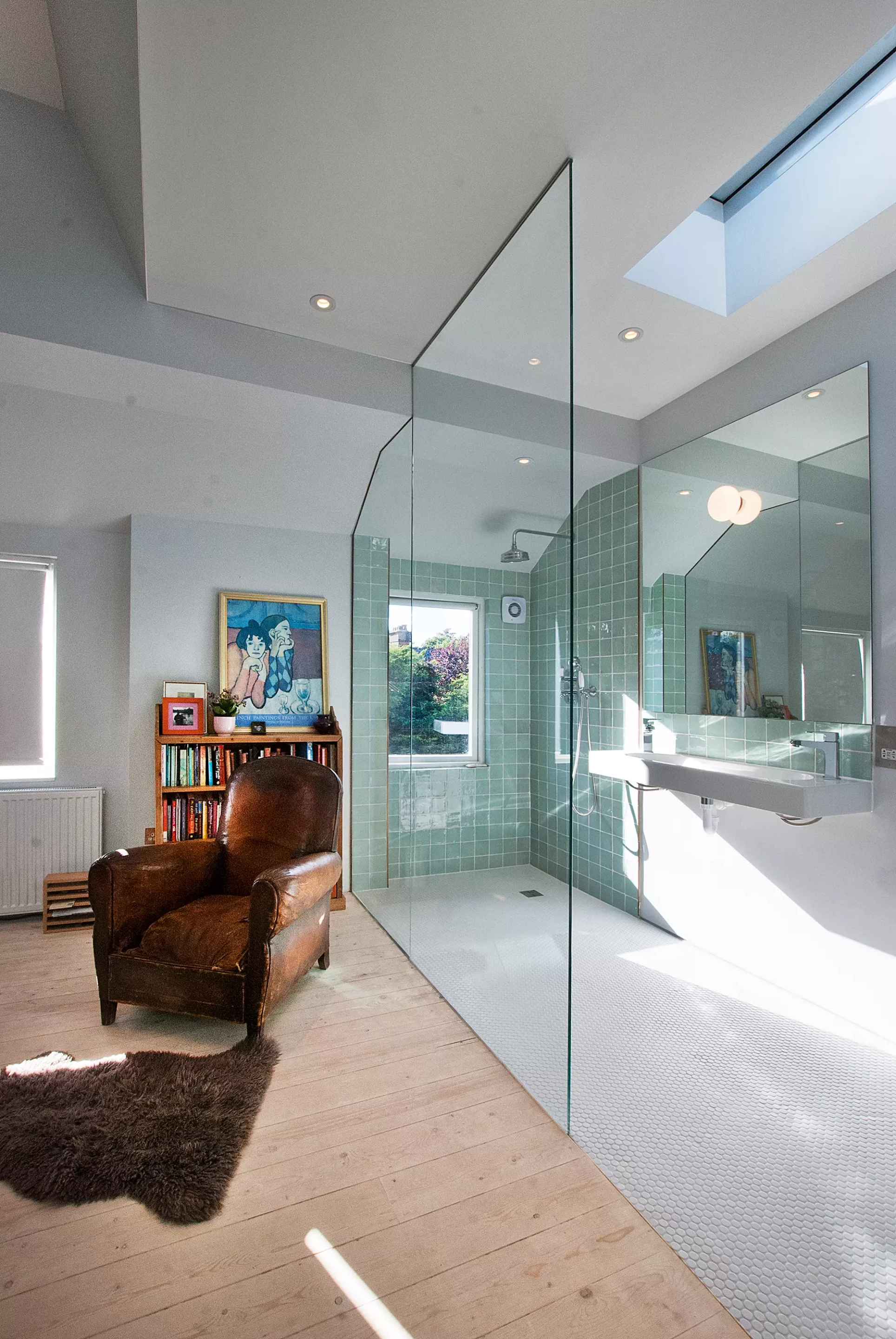
This Edwardian home renovation in London features a walk-in wet room. Rooflights provide plentiful daylight, creating a bright, airy zone
Experimenting with scaled floorplans can be done the old-fashioned way – with graph paper and a pencil – or by using an online planning tool. For example, there’s many online services that’ll allow you to experiment with layouts and create a virtual view in just a few steps. But don’t forget that you’ll need to incorporate ventilation, plumbing and electrics, plus circulation space around showers and baths.
If you’re working with a limited amount of room, there are plenty of clever design tricks to create the illusion of more space. “Wall-hung sanitaryware is a possible solution that will create more light across the floor, plus make for easier cleaning,” says Kate from Kohler.
If there’s a particular range of fittings you like, check to see whether smaller versions of each unit are available, as every free centimetre will count once the zone is complete. Adequate storage to hide away lotions, potions and other bathroom clutter is also essential. If space is an issue, look out for slim, wall-mounted basins that double up as cabinets.
Words by Sander Tel & Rebecca Foster






























































































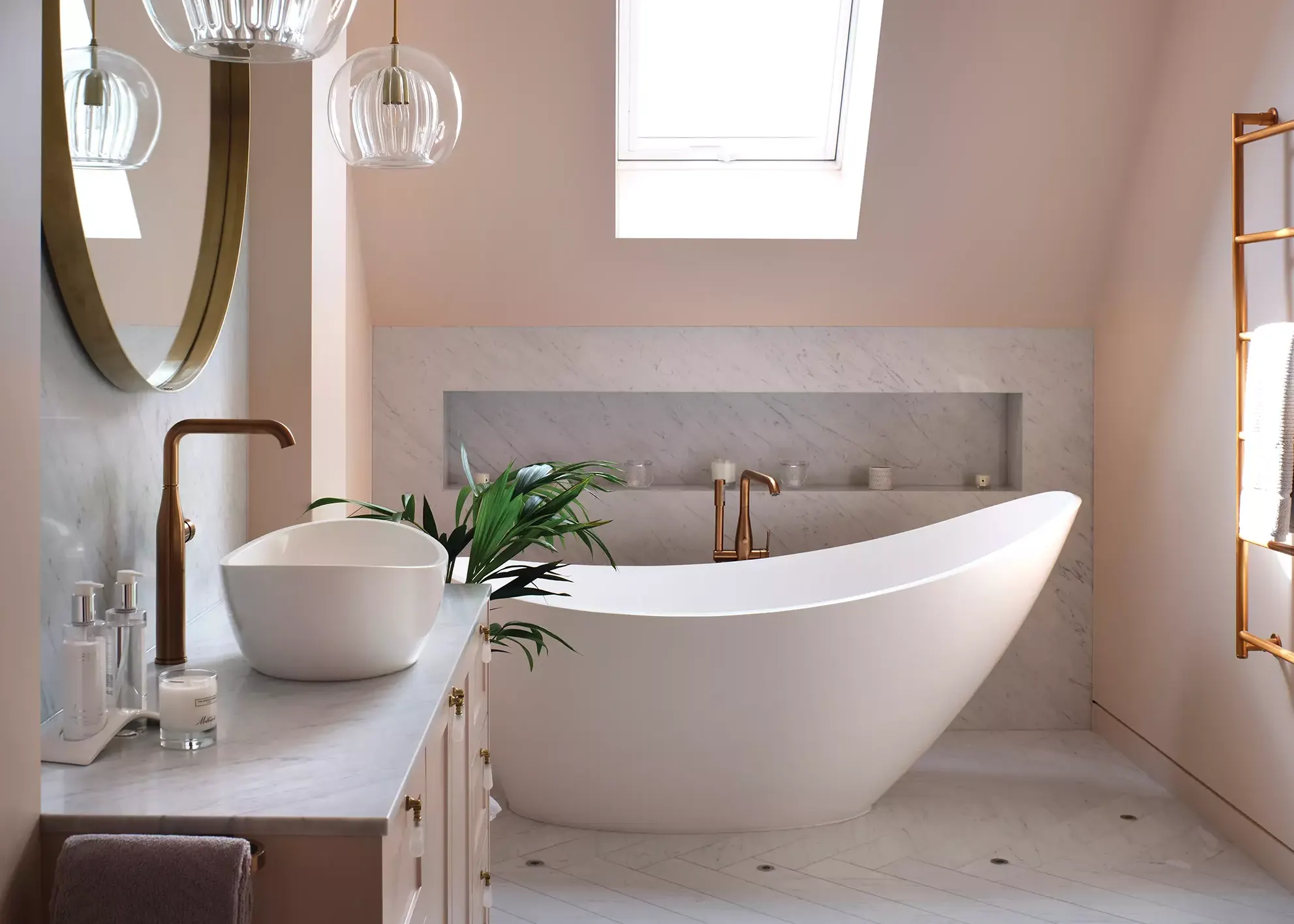
 Login/register to save Article for later
Login/register to save Article for later

